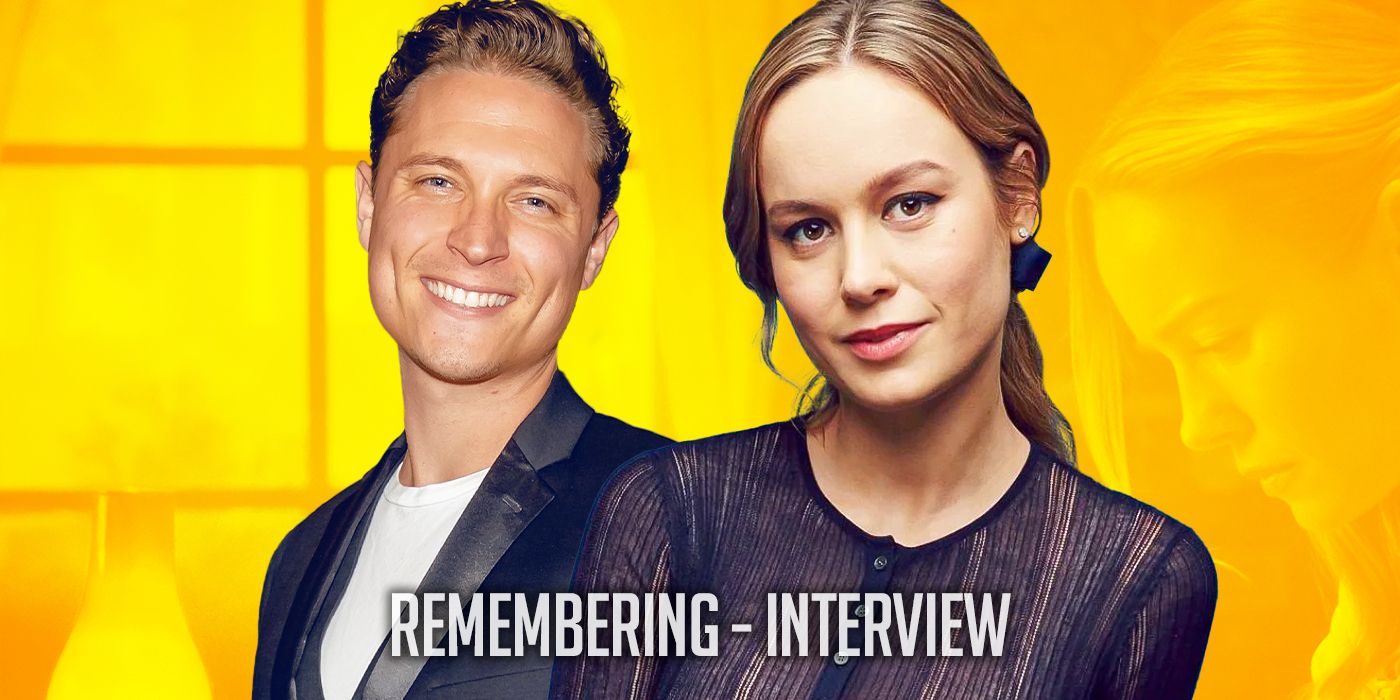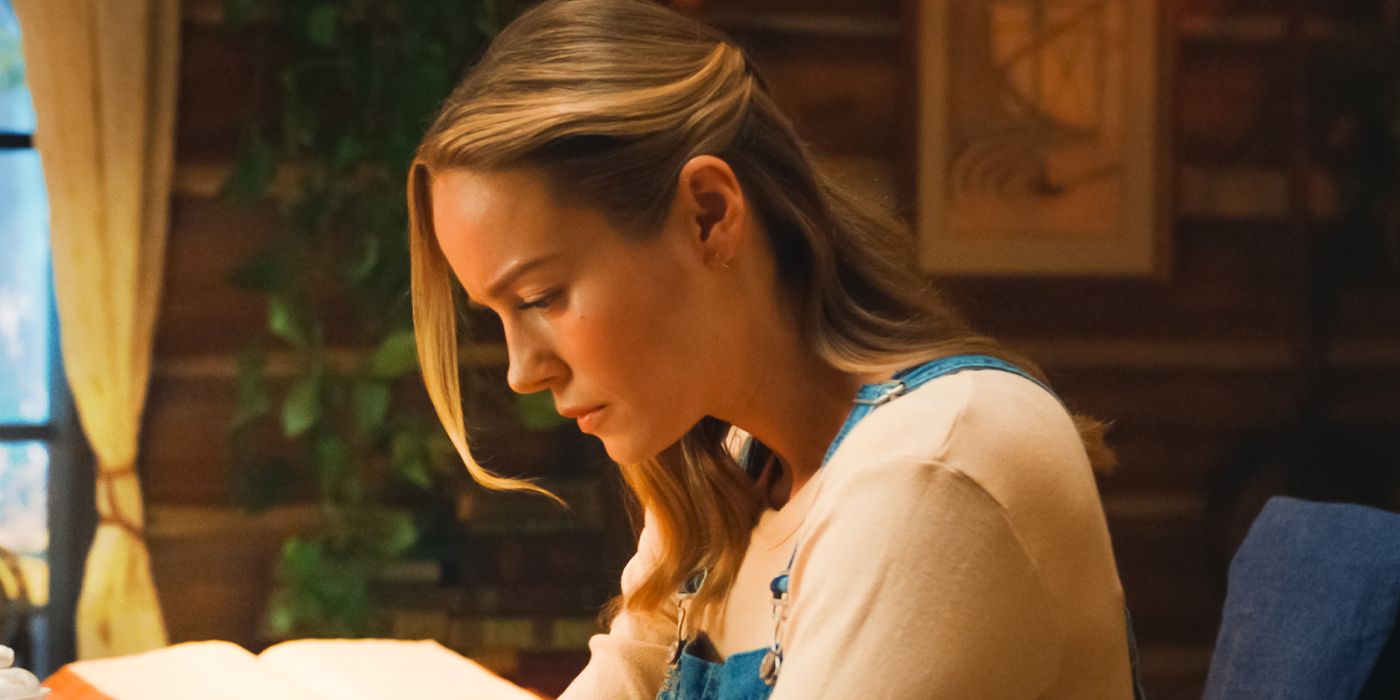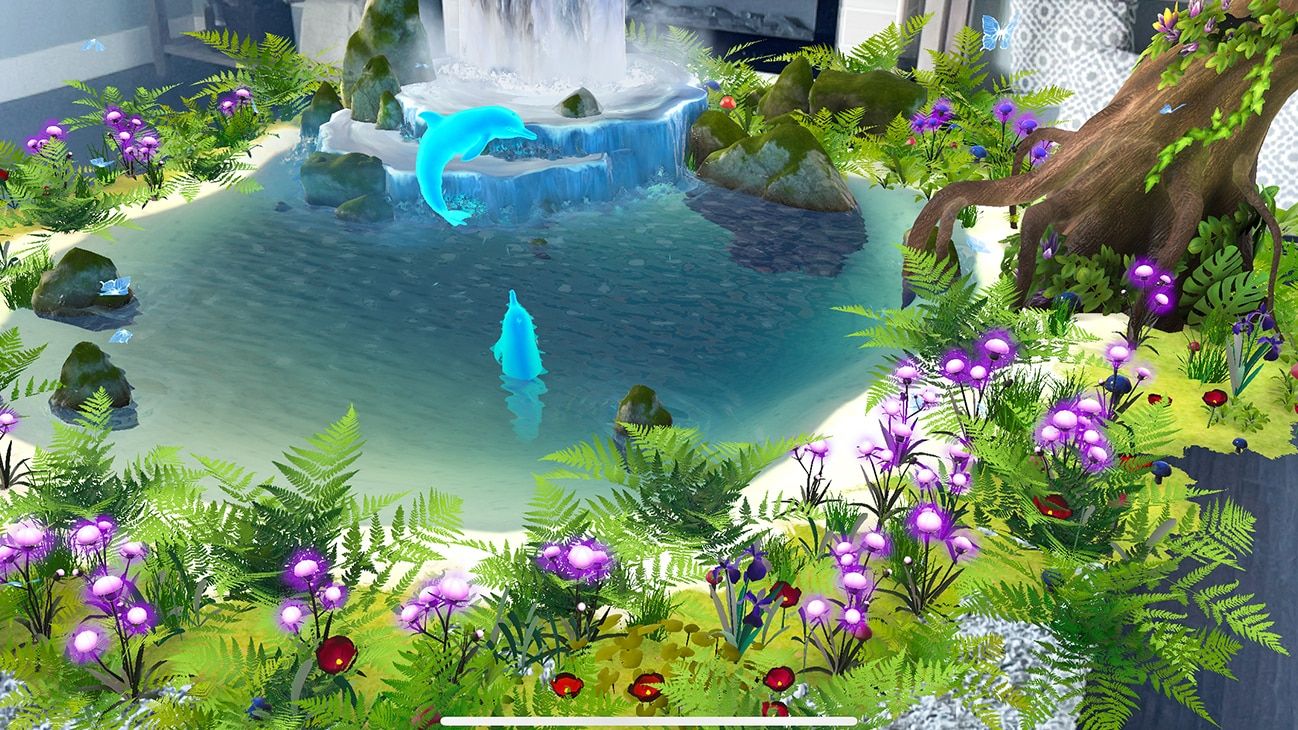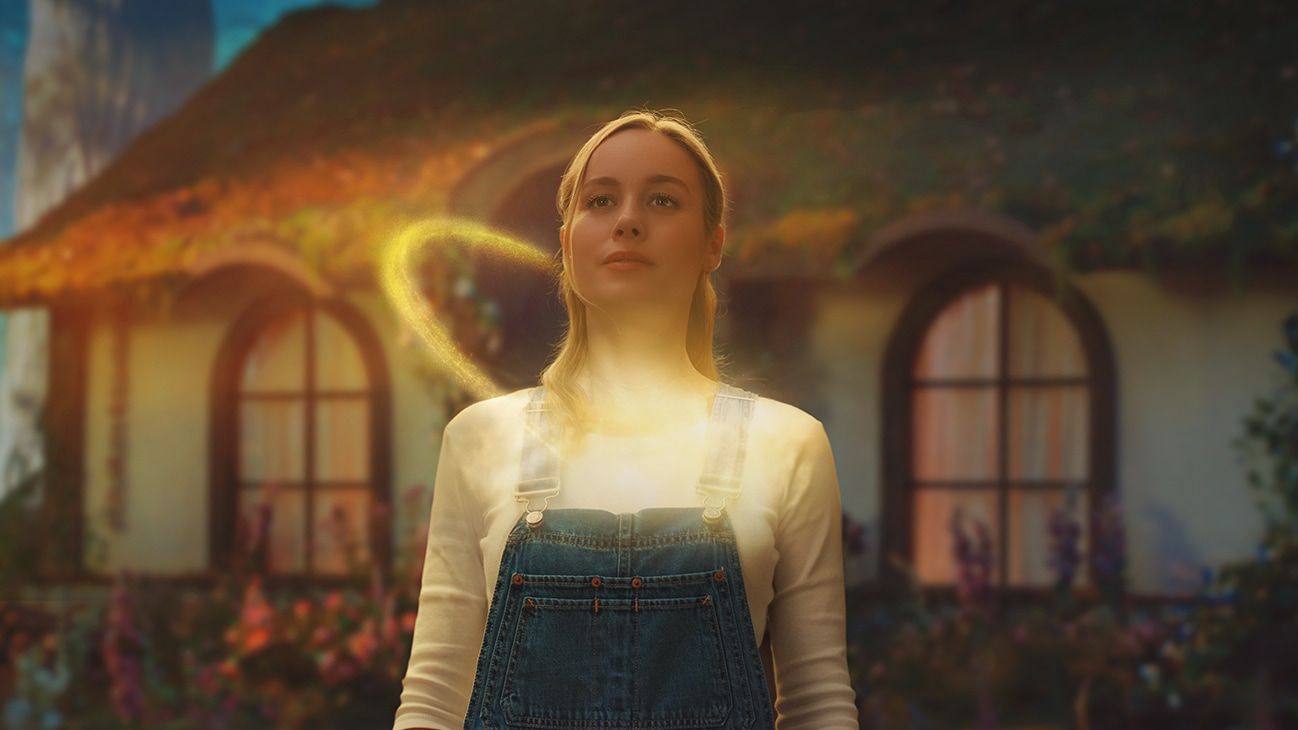From Emmy Award-winning director Elijah Allan-Blitz and Academy Award-winning actress Brie Larson, the eight-minute short fantasy film Remembering, available to stream at Disney+, follows a writer who loses an idea when her phone rings, illustrating how easily life’s daily distractions can cause us to lose track of what’s important. When that idea is found by the writer’s inner child, the viewer accompanies them on a journey through The World of Imagination that helps them realize they can still find inspiration in ideas, if only they remember. To take this world one step further, Disney+ subscribers can interact with the story through a companion Augmented Reality app by scanning the TV and extending The World of Imagination directly into the room they’re watching in.
Collider, along with a couple other media outlets, was invited out to the Studio Lab at Walt Disney Studios to check out the short, preview the AR app, and chat with Allan-Blitz and Larson. During the interview, the two talked bout how the concept for Remembering evolved, working with their young star Dusty Peak, designing the world from her imagination, incorporating the technology, the support and feedback they’ve gotten from other filmmakers, maintaining a very strong interior world in life, and where all of this could go next.
Question: How did you guys come up with the concept for Remembering?
ELIJAH ALLAN-BLITZ: It really was inspired a lot by Elizabeth Gilbert’s work and the genesis of ideas. What are ideas? Are they something that are from us, or are we conduits for them? It was about exploring the idea that an idea can be something that gets lost, and what happens to it? How connected to it are we? Is it a separate entity? Where does it go when it’s forgotten? How can we find it? And then, being able to have something like our creative spirit to bring that back to us, in this case, represented by our inner child.
BRIE LARSON: Who’s also our neighbor. Elijah and I had been talking, it was the pandemic, and we were needing to be creative. We had been watching movies from our childhood and digging into all of these things. One day, Elijah went into the office, and I feel like it was within 20 minutes, but maybe it was an hour, he had this whole concept. And then, parallel to that, some parents in our neighborhood had asked if I would give art lessons to their kids. As I was doing that, the youngest one, Dusty [Peak], was just saying stuff where I was like, “How do you know that?” She’s so tapped in and can build worlds so easily. Elijah has known Dusty for years, and I was like, “We’ve gotta start paying more attention to what this kid is saying.
ALLAN-BLITZ: I think she actually came back and said, “You need to make a movie with Dusty.”
LARSON: Okay, I didn’t wanna give myself that credit, but yes, I did. He had already had this concept, and then it was plugging this in. Part of the beauty of it was, what is the world of imagination? What does that look like? We let her help dictate what that would be. We’d have her come over, and I put my podcast mic in the living room, and she’s our buddy. She’s my friend. It’s like there’s no difference in age. So, she would come over to hang out, and we would ask her questions. There’s even more gold. If we were given the opportunity to expand this into a feature, the amount of stuff that she talked about, it’s a very detailed world. This world of imagination, there’s a lot happening, but too much to put into seven minutes. We have hours of her talking about it and it’s so cute. It’s so real and fluid and self-conscious, in any way. And so, we took some of those things, like I love unicorns, but I’d never thought about a unicorn made out of moonlight. And then, Elijah went through all the audio and pulled bits and pieces of it, and then worked with an artist to then build that out. That shot that you see, when she’s on the bluff and she’s looking at it and you see that reaction, that’s her. She just didn’t know. She doesn’t know what a volumetric stage it is. She had no idea that she would be walking in to a world that was this true visual representation of what she sees in her mind. It was a really beautiful experience to play with her in that, and her mind was going wild while we were there because she started realizing that she could play in this space and that this space was hers, that she had created. We got to have two days with her, in this incredible space.
Were you with her on stage? Even though you’re a ball of light, were you right next to her?
LARSON: Yeah. We have some good BTS of me, curled up in a ball, talking with her. I was the light. I played the idea and talked with her. With some of it, we knew some of the core ideas of things that she said, but some of it was just letting her riff a little bit more. “I remember when I was big,” was something that she said, and it was just like, “Oh, God. Okay.” It was a great experience for us. [Elijah] is my partner in everything, in love and in life and in creativity, so to be able to do this together was just a dream. The whole thing was just dream.
ALLAN-BLITZ: We’ve both worked with kids, in different capacities, through our whole lives. This was just an incredible opportunity that the Studio Lab team has helped us provide, to be able to create this world, and then bring this child into it and create this film. We never called, “Action” once while she was on set. We told her the camera was a robot friend named Alexa and we were playing a staring contest. We said, “You don’t look at Alexa,” and that was it. We just started having fun and having these conversations, and things were happening around her. She was seeing this whole world. When you saw the light reflected in her eyes, that was really a real reflection, from the stage.
Have you guys always been tech people? It’s one thing to come up with the idea for this, but it’s another to want a waterfall to come out of the screen too. Was that just how you always pictured this?
ALLAN-BLITZ: The waterfall was actually something that, from the very beginning, when we first started talking about this, was there. We knew there had to be this element and that it had to come out of the TV. It’s one thing for these elements to appear in your room, but there had to be something that actually came off of the TV into your room that connects it. Also, having the character of the idea, being able to come out into your living roo, is a really important part of it. We’ve been talking about this idea for years, but it was only really connecting with the Studio Lab team that it was actually made possible. We’ve been told this was not possible for so long, and then it was like, “Well, actually, I think there’s a way.” We all jumped in with both feet, not really sure because there’s no roadmap. We’re doing something that’s never been done, and an incredible group of people made it happen.
LARSON: The tech stuff was all really in [Elijah]. He’s been talking about this for many, many, many years. I even remember the first time he told me about it, I was like, “You’re talking about what? How does that work?”
ALLAN-BLITZ: I was like, “It’s gonna come off your TV.”
LARSON: And I was like, “But how does it come off the TV?” Now that we have it, it’s been so great to actually be able to share with people. Once you see it, it clicks. What works about it is that it’s not distracting from the story, it’s aiding in the storytelling. It’s bringing you closer to these characters. It’s bringing you closer to the inner child and closer to the world of imagination. We’re not saying every single film needs to have this element, but for those that would benefit from it. I love my job and I love acting. I love that it’s like a message in a bottle and people get to connect with it. And this is a way for them to even get closer to what it is that I love about my job. It’s a really exciting opportunity. For us, in our mind, this is just the beginning of what is possible. This is just the bridge to what can come after that?
Brie, what does it even feel like to be in a position in your career and your life to where you can have an idea and make it happen? You have people like Kevin Feige, John Favreau and Destin Daniel Cretton lending their support. What’s it like to be in a position to actually be able to get a project like this made?
LARSON: Well, it’s not that simple, right? We were told no, a lot of times. It’s not like I can go, “Hey, we’ve got this great idea. Disney, gimme a bunch of money to do it.” It’s still a process. Yes, I have privilege beyond what I had many years ago, but it takes a lot of conversation and it takes a lot of support. One of the things that I’ve learned through this is that you never know who’s gonna be your friend, in the end. We showed this to Steven Spielberg. He’s somebody that cast me in my first big role when I was 18, so we went to Amblin and showed it to him. It was a very full circle moment for me because I felt like he gave me this gift, and then we were able to give him this gift. This was something that he was always very interested in, and we were able to figure this out. He was like, “Can I use this?” This is something to be used. It’s very special, and it just continues to expand my mind, as to what’s possible.
Where did the idea come from, to have things pop out of the screen? Was it pop-up books, as a kid, or video games? Where did that come from?
ALLAN-BLITZ: The initial genesis of it came from working a lot in VR. I could see the translation of the mediums and the limitations of the headset compared to something that we’re all used to watching on a giant rectangle (television). I knew it was there and I knew it was gonna happen at some point, and I knew it was too cool an opportunity to not just keep pushing forward on. Another thing that was really important about it was that this was part of the story, from the beginning. It wasn’t like the AR component was an app afterthought. This was completely baked in from the original idea. When we were talking about putting this thing together, we knew it had to be this immersive experience that had never been done before. Especially with stuff that we’re both so passionate about, like the world of imagination and your inner child and creativity, and where do ideas come from, and then being able to bring that into your room, we wanted it to enhance and immerse you more in the story.
How do kids react when they see this?
ALLAN-BLITZ: It’s amazing. It’s amazing watching families interact with it. It almost feels like kids are much less surprised by any of it. They’re just like, “Oh, of course, that’s what happens.”
LARSON: Adults tend to have a little bit more trepidation. They’re a little bit more like, “Am I gonna break it? Am I allowed to do this?” Even without the AR component, when you show it to kids, we’ve asked them, “So, what do you think?” And they’re like, “Yeah, that’s what the world looks like.” I remember one little girl was like, “I think there would be more butterflies.” And then, we played it again and she was like, “Oh, no, actually, I was wrong. I just didn’t notice some of them. That’s the right amount of butterflies.” There’s an expectation that this is for children, but when families watch it together, it tends to be the parent that goes, “I didn’t know that this was the message that I needed.” For the kids in the household, they’re more like, “Yeah, of course.”
Brie, do you feel like being an actor has really helped keep you more in touch with your own creativity and imagination?
LARSON: It’s hard to know because this is the path that I’ve been on, but I have a really strong interior world that I really enjoy being in. I feel like getting to create has just always been the way that I process. The world is beautiful and strange, and I don’t know how other people make sense of it, but the way that I make sense of it is that I organize it through this stuff. It’s also a way of testing whether I’m alone. I put it out and it’s like, “Do you feel that way, too?” It’s so life-affirming for me to experience, even just once, having someone say, “I understand.” You go, “Oh, okay, so I’m not alone in my experience.”
Did your experience directing Unicorn Store play into any aspect of this?
LARSON: Unicorn Store was just informative, in that I learned so much about the larger picture of filmmaking. I learned more about how to be a better teammate, how to be a better actor, and how to better assist a director. That’s been a huge part of it, learning when I’m being in support and when I’m hindering the process. It’s so fluid for the two of us to work together. We have such a shorthand, to the point where we don’t have to talk, and I trust him implicitly with decisions. Because we both have this larger understanding of how to make something, it allows for the collaboration to be very fluid and satisfying, and really just very additive to our lives.
ALLAN-BLITZ: For sure. But also, between Brie’s love of unicorns and Dusty’s love unicorns, there was no question that there were gonna be unicorns in this movie.
LARSON: We put a unicorn on the door of the cottage.
You mentioned how you’ve spoken to so many filmmakers about this. What’s the feedback been like? Are you hoping to collaborate with more filmmakers on this?
ALLAN-BLITZ: Yes, for sure. All the incredible people that we’ve gotten to show this to, it would be an honor to work, in any capacity, with any of them. The feedback has all been very different. There’s the same level of amazement, but all of them have different levels of experience with this technology, or similar things. A lot of it has just been showing them that we actually did this.
LARSON: Ultimately, for us, we just wanna keep creating. With this, we can finally share what it is that we’ve been talking about, visually. Now, it’s like, “Okay, how do we expand this? Is it expanding this story into a feature? Is it expanding it into a series? Is there another film, altogether, that could use this technology, plus all the other things that we’re talking about, that the future could hold? How can we progress? This is just a taste of what we’re capable of.
What’s next with this, aside from AR glasses? What does this do for the medium of storytelling?
LARSON: It breaks the rectangle. One simple next step would be that you could interact with it. We’ve talked about how a future version of this could be, you stick your hand out and a bird will land on your finger. There are Easter eggs. There are ways of continuing to explore and have the story expand, the more that you spend time with it. And then, whenever the glasses happen, that opens up a whole new world, in terms of what that means for the living room and also what that means for theaters. Those are two really exciting ideas. Not for every single film that we do, is that necessary. We were promised 3D, but with this, you could bring an experience that was in the theater home, in a way that we never dreamed was possible.
ALLAN-BLITZ: I actually showed this to Quentin Tarantino, and he was like, “So, it’s like 3D?” And I was like, “No, it’s not 3D. It’ll actually come out.” It’s hard to wrap your mind around that you actually can see it come out of your TV and into your living room.
Remembering is available to stream at Disney+.




